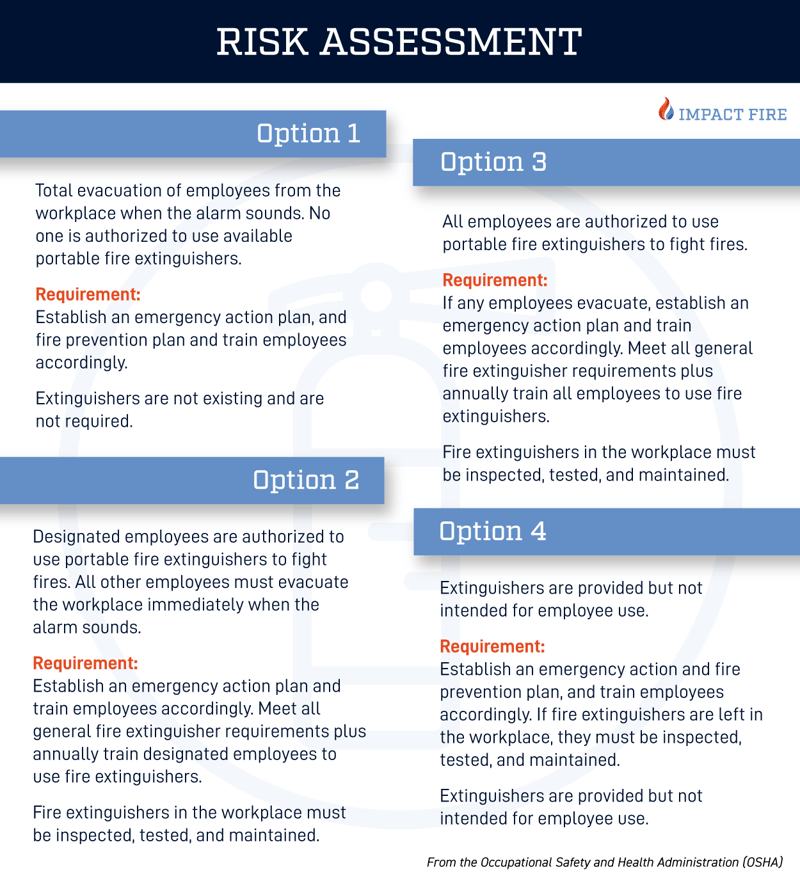Most people understand the importance of proper workplace fire safety measures. After all, we spend about one-third of our adult life at work. So it makes sense that workplaces— the place where we spend so much time—need to be secure and protected from fire. It’s why we have building fire codes and other protective measures.
However, what isn’t as clear is who’s responsible for fire safety in the workplace. What are the employer and employee's fire safety responsibilities, and what is managed by outside vendors?
Let’s break down essential aspects of workplace fire safety and spell out whose job it is to ensure those aspects are met.
Employer Fire Safety Responsibilities
Employers play a crucial role in enforcing fire protection measures in the workplace. According to the OSH Act, they are responsible for providing a safe workplace. Here are a few key employer fire safety responsibilities.
Create and Document a Workplace Fire Preparedness Plan
It’s your responsibility as an employer to create a fire preparedness plan that covers how to prevent fires from occurring and what to do if a fire breaks out. Your documented plan should include all emergency procedures and escape routes.
OSHA states that a business’s emergency action plan must provide the “designated actions that employers and employees must take to ensure safety from fire and other emergencies.” OSHA requires that employers record emergency action plans in writing unless there are 10 or fewer employees.

Educate all Employees on Fire Safety Procedures
It’s not enough to have a documented fire preparedness plan. Employers need to educate each employee about the plan at the following times:
- When the plan is first developed
- When the employee is assigned any specific duties or responsibilities relating to the emergency action plan, or when those assignments change
- When the plan itself changes
Provide and Maintain the Required Fire Prevention and Protection Equipment
The building owner will typically ensure the workplace is compliant with the latest fire codes, but there are other pieces of fire protection equipment employers must provide and maintain.
Employers must ensure they implement the right processes for providing, inspecting, and maintaining portable fire extinguishers, special hazard fire suppression systems, emergency lighting, and other fire safety equipment.
Train Employees on Proper Use of Fire Safety Equipment
According to OSHA, when employers provide fire protection equipment such as portable fire extinguishers and fire suppression systems, they must also provide employee training on the proper operation of the equipment. It is your responsibility as an employer to provide employee training on fire safety equipment at least once per year.
Employee Fire Safety Responsibilities
It’s everyone’s responsibility to prevent injuries, promote prevention, and maintain a safe environment. Employees are often the first line of defense when it comes to responding to and preventing workplace fires. Here are a few key employee fire safety responsibilities.
Understand Your Options in a Fire (Fight or Flight)
Employees have two options: fight or flight if a fire breaks out in the workplace. What employees don’t have, however, is an obligation to do one action or the other. Some companies try to implement policies stating that employees are prohibited from operating fire protection equipment to fight an incipient-stage fire. But it’s not lawful to prevent a person from protecting themselves.
Likewise, employees can’t be required to suppress a fire in the workplace. The decision to fight or flight is entirely up to the employee. Proper employee fire extinguisher training helps people take the right action faster.
Practice Proper Safety Procedures
Employees are responsible for paying attention to the safety procedures laid out in the company’s action plan. Employees must take charge of their life safety by participating in training and carefully reading through documented plans.
Often, employees take on safety leadership roles in the workplace. Whether it’s by nature of their job, such as in the industrial and manufacturing industries, or whether they are volunteer safety officers in the office, employees sometimes lead their peers in fire protection, including:
- Directing people to follow procedures in an evacuation
- Staying behind to perform duties such as shutting down specific equipment
- Setting up fire safety training
Fire Protection Service Provider Fire Safety Responsibilities
Many aspects of fire prevention can be outsourced to a fire protection company, including employee fire extinguisher training. Outsourcing reduces the liability for your company while ensuring that critical inspections and maintenance happen regularly. A certified fire protection vendor should handle the installation, inspection, and maintenance of the following fire and life safety equipment:
- Fire pumps
- Fire extinguishers
- Emergency lighting
- Fire alarm systems
- Fire sprinkler systems
- Special hazard fire suppression
- Kitchen fire suppression systems
- Passive fire protection equipment
Preventing Fires in Your Workplace
Everyone within an organization has specific responsibilities when it comes to fire safety. Knowing your responsibilities—and taking the proper action—can help protect your business and save lives. To learn more about creating your complete fire safety plan, download the Workplace Fire Safety Guide.
Editor's Note: This post was originally published on April 22, 2019, and has been updated for accuracy and current best practices.








